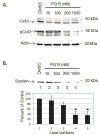Anti-breast cancer agents, quinolines, targeting gap junction
- PMID: 21801150
- PMCID: PMC3296117
- DOI: 10.2174/157340611796799131
Anti-breast cancer agents, quinolines, targeting gap junction
Abstract
Cancer cells exhibit many defects in cell communication that contribute to the loss of tissue homeostasis (excess cell proliferation, invasion, and metastasis). The process of cancer formation causes a disruption in cell homeostasis, affecting the ability to respond to extracellular signals, as well as triggering some intracellular events which alter gap junctional intercellular communication (GJIC). Previous research has shown that the first two generations of substituted quinolines have anti-cancer effects in human breast cancer cells. This report presents the synthesis and bioactivities of third generation substituted quinolines. Scrape load/dye transfer studies showed that 100 nM of PQ15, a third generation substituted quinoline, causes a 4.5-fold increase of gap junction activity in T47D breast cancer cells. Furthermore, a significant decrease of cell proliferation and viability was observed in the presence of 200 nM PQ15 compared to control. The expression of α-survivin was reduced to <40% in the treatment of 200 nM PQ15 compared to solvent alone. Alpha-survivin expression is upregulated in human cancers and associated with resistance to chemotherapy, suggesting that α-survivin prolongs the survival of cancer cells. Thus, it has been shown that substituted quinolines stimulate gap junction activity, decrease alpha survivin expression, and subsequently inhibit cancer cell growth. Our findings demonstrate that PQ15 has a promising role in exerting anti-cancer activity in human breast cancer cells.
Figures





References
-
- Topper YJ, Freeman CS. Multiple hormone interactions in the developmental biology of the mammary gland. Physiol Rev. 1980;60(4):1049–106. - PubMed
-
- Deome KB, et al. Development of mammary tumors from hyperplastic alveolar nodules transplanted into gland-free mammary fat pads of female C3H mice. Cancer Res. 1959;19(5):515–20. - PubMed
-
- Loewenstein WR, Kanno Y. Intercellular communication and the control of tissue growth: lack of communication between cancer cells. Nature. 1966;209(5029):1248–9. - PubMed
-
- Goldberg GS, Martyn KD, Lau AF. A connexin 43 antisense vector reduces the ability of normal cells to inhibit the foci formation of transformed cells. Mol Carcinog. 1994;11(2):106–14. - PubMed
Publication types
MeSH terms
Substances
Grants and funding
LinkOut - more resources
Full Text Sources
Medical
Miscellaneous

